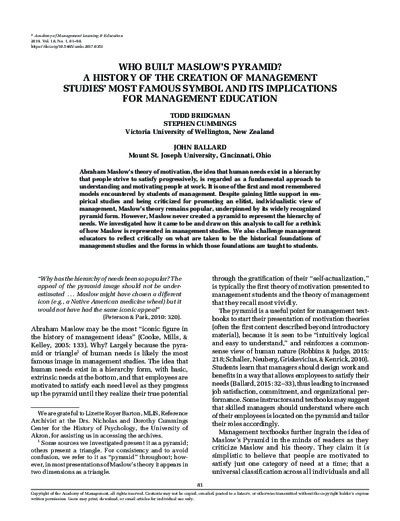 Diese Seite wurde seit 3 Jahren inhaltlich nicht mehr aktualisiert.
Unter Umständen ist sie nicht mehr aktuell.
Diese Seite wurde seit 3 Jahren inhaltlich nicht mehr aktualisiert.
Unter Umständen ist sie nicht mehr aktuell.
 Zusammenfassungen
Zusammenfassungen
Abraham Maslow’s theory of motivation, the idea that human needs exist in a hierarchy
that people strive to satisfy progressively, is regarded as a fundamental approach to
understanding and motivating people at work. It is one of the first and most remembered
models encountered by students of management. Despite gaining little support in empirical
studies and being criticized for promoting an elitist, individualistic view of
management, Maslow’s theory remains popular, underpinned by its widely recognized
pyramid form. However, Maslow never created a pyramid to represent the hierarchy of
needs. We investigated how it came to be and draw on this analysis to call for a rethink
of how Maslow is represented in management studies. We also challenge management
educators to reflect critically on what are taken to be the historical foundations of
management studies and the forms in which those foundations are taught to students.
Von Todd Bridgman, Stephen Cummings, John A. Ballard im Text Who Built Maslow’s Pyramid? (2019)  Dieser wissenschaftliche Zeitschriftenartikel erwähnt ...
Dieser wissenschaftliche Zeitschriftenartikel erwähnt ...
 Personen KB IB clear | Pedro De Bruyckere , Jill Butler , Kritian Holden , Casper D. Hulshof , Paul A. Kirschner , William Lidwell , Abraham Maslow , Douglas McGregor , John Broadus Watson , Ken Wilber | |||||||||||||||||||||||||||||||||||||||||||||||||||||||||||||||
 Begriffe KB IB clear |  Bedürfnispyramide
, Bedürfnispyramide
,  Management Management management
, management
,  Motivation Motivation motivation
, motivation
,  Wissenschaft Wissenschaft science science
| |||||||||||||||||||||||||||||||||||||||||||||||||||||||||||||||
 Bücher |
|
 Zitationsgraph
Zitationsgraph
 Zitationsgraph (Beta-Test mit vis.js)
Zitationsgraph (Beta-Test mit vis.js)
 Anderswo finden
Anderswo finden
 Volltext dieses Dokuments
Volltext dieses Dokuments
 |  Who Built Maslow’s Pyramid?: Artikel als Volltext ( Who Built Maslow’s Pyramid?: Artikel als Volltext ( : :  , 753 kByte; , 753 kByte;  : :  ) ) |
 Anderswo suchen
Anderswo suchen 
 Beat und dieser wissenschaftliche Zeitschriftenartikel
Beat und dieser wissenschaftliche Zeitschriftenartikel
Beat hat Dieser wissenschaftliche Zeitschriftenartikel während seiner Zeit am Institut für Medien und Schule (IMS) ins Biblionetz aufgenommen. Er hat Dieser wissenschaftliche Zeitschriftenartikel einmalig erfasst und bisher nicht mehr bearbeitet. Beat besitzt kein physisches, aber ein digitales Exemplar. Eine digitale Version ist auf dem Internet verfügbar (s.o.). Es gibt bisher nur wenige Objekte im Biblionetz, die dieses Werk zitieren.














 Biblionetz-History
Biblionetz-History